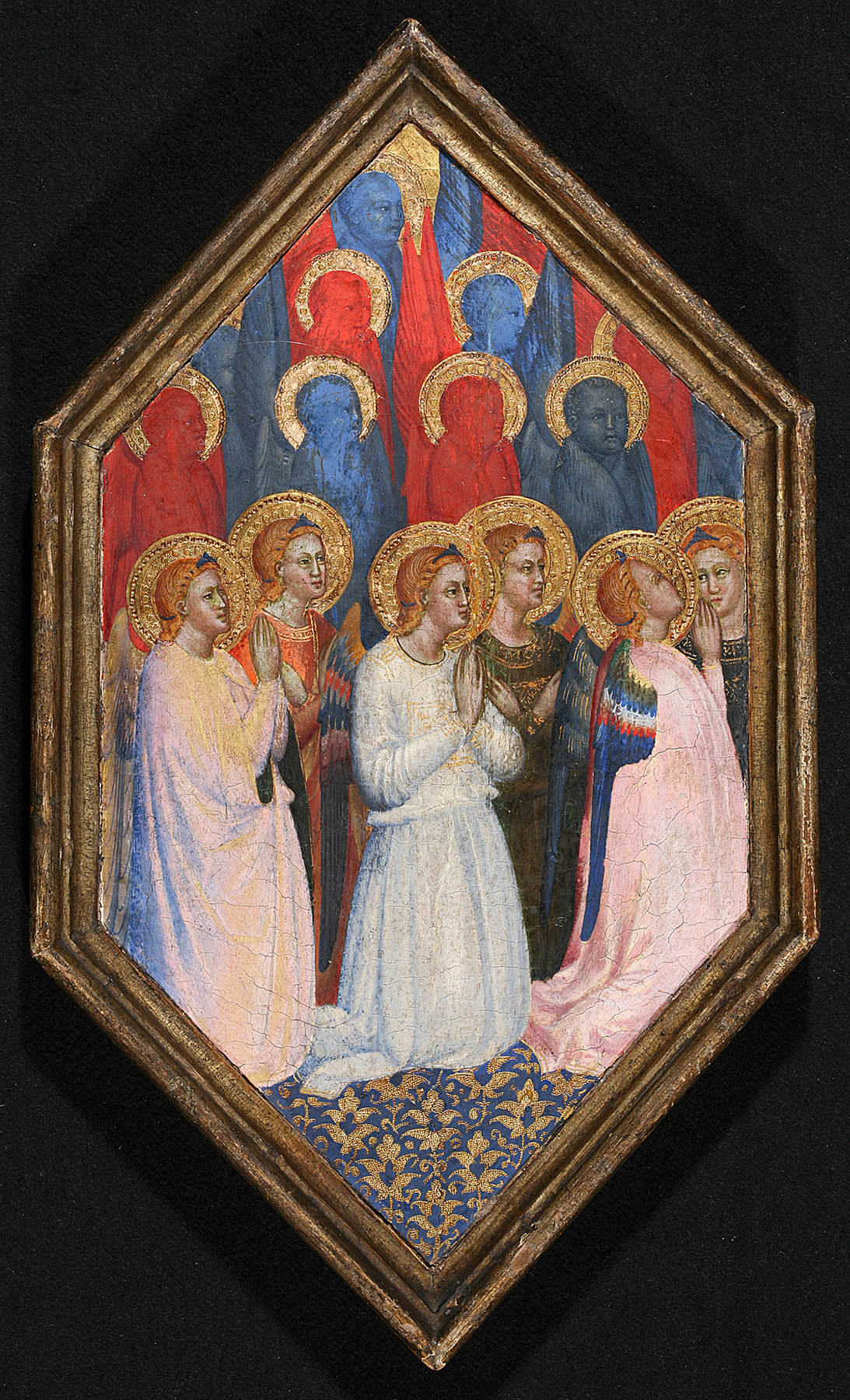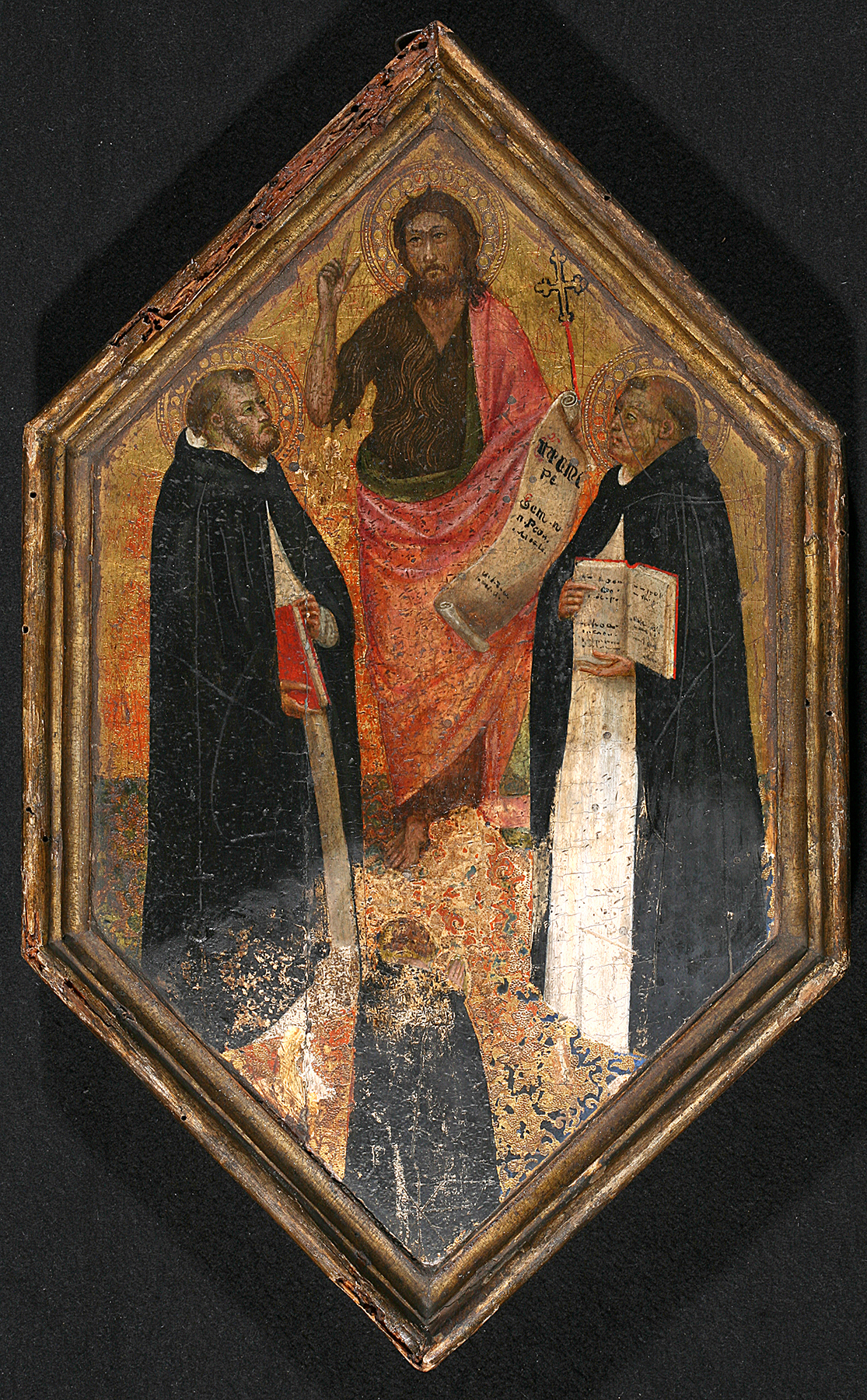James Jackson Jarves (1818–1888), Florence, by 1859
The panel, of a horizontal wood grain and evincing scarcely any warpage, preserves its original thickness of 3.8 centimeters. A prominent knot at the upper right has not provoked any movement or damage in the corresponding area of the paint surface. The engaged moldings along the two top edges of the pedimental shape are largely original; although repaired in spots, they preserve traces of their original gilded surface. The panel and these two moldings have been encased in a larger series of engaged moldings nailed and glued to them, including carved crockets along the upper edge, a stepped molding along the bottom edge to match the original moldings at the top, and a tabernacle-style base carved out of old, worm-eaten wood. These additional moldings, probably dating to the nineteenth century, were gilded, and the frieze in the base painted blue, but the gold and color in the left half of the structure were stripped back to the wood during a cleaning of 1963–67. The paint surface is in exceptionally good condition, except for scraping of the color in the aforementioned restoration campaign that has resulted in numerous small local losses scattered throughout. These are densest in the gray areas of the landscape and around the contours of the figures where they overlap the landscape.
The painting represents an unusual combination of two unrelated subjects: the Nativity and the Resurrection of Christ. At the left, the manger that served as a crib for the Christ Child is set on the ground in a rocky landscape before a stone building with a projecting thatched awning. The Virgin is seated on the ground further to the left, supporting her Child that He might be seen by two shepherds who kneel in adoration at the right and by the ox and ass behind the crib. Saint Joseph fills the lower-left corner of the picture field; like the Virgin, he is seated on the ground but with his head resting on his hand, apparently asleep. At the top center of the triangular field, the Resurrected Christ floats majestically against the gold ground, holding a staff and banner with a red cross against a white field. His empty tomb is nestled among the rocks below Him and to the right. Four sleeping soldiers sprawl on the ground in front of the tomb. A castle—unrelated to the narrative of either the Nativity or Resurrection—occupies a distant hilltop in the landscape behind Christ to the left.
The painting was listed as a work by Giottino in inventories of the James Jackson Jarves Collection and in the earliest publications concerning that collection at Yale but was correctly reclassified by Osvald Sirén as having emerged from the circle of painters gravitating around Orcagna in the third and final quarters of the fourteenth century.1 Sirén specifically assigned it to Orcagna’s youngest brother, Jacopo di Cione, a contention rejected by Richard Offner, who, however, proposed no alternative attribution other than to “some obscure Florentine eclectic of the end of the fourteenth century.”2 Offner’s dismissive appraisal seems to have dogged the painting throughout its subsequent publication history. It has been called Mariotto di Nardo,3 style of Jacopo di Cione,4 and school of Agnolo Gaddi.5 All of these designations would place its execution in or near the last decade of the fourteenth century, as would a more serious attempt by Miklós Boskovits to find a name for its author: Cenni di Francesco di ser Cenni.6 It may be assumed that Boskovits’s proposal was based on generic similarities of figure types, especially those of the Virgin and Saint Joseph in the Nativity scene at the left of the Yale panel, but if so, these are superficial points of comparison. Cenni di Francesco, whose presently accepted oeuvre in large measure results from Boskovits’s reconstruction, is invariably a more nervous and angular painter than is the artist of the Yale panel, employing more attenuated and slightly stiffer figural proportions. Comparison to a predella panel by Cenni di Francesco in the Philadelphia Museum of Art, representing the Nativity and Adoration of the Magi,7 reveals both similarities and significant differences in composition, spatial structure, and architectural and figural motifs to the Yale panel. The more compact, rounded figures in the Yale panel, with their outsize yet doll-like features, instead conform exactly to those in paintings commonly thought to be early works by Matteo di Pacino, the painter formerly known by the designation Master of the Rinuccini Chapel. They are all but interchangeable—as are the punch patterns lining the margins of the gold ground—with those in four hexagonal panels divided among museums in Berlin (figs. 1–2) and Altenburg8 and a private collection in New York; these works were also, correctly, recognized as works by Matteo di Pacino by Boskovits.9


The pedimental shape of the Yale painting, which has not been altered except by encasement within a nineteenth-century frame to lend it the semblance of an independent work of art, has led to the supposition that it functioned as the pinnacle of a small altarpiece or of a large devotional panel. Altarpiece pinnacles in this period, however, were nearly always more steeply gabled and were generally painted on supports that were either continuous with the panels of the register beneath them, in which case the wood grain would be vertical, or with the engaged frame moldings attached to the lower panels, in which case, more often than not, the wood grain would be diagonal, running parallel to one of the upper edges of the gable. The thickness of the present panel and the condition of its reverse, undamaged by worm channels, argue against its having been part of any frame member engaged to another panel, while its horizontal wood grain suggests that it was not originally part of any conventional altarpiece or devotional work. It is worth considering instead the hypothetical possibility that it could be a surviving fragment from a project on which Matteo di Pacino was engaged from 1371 to 1373, painting beds in the hospital of Santa Maria Nuova in Florence commissioned by Cavalcante dei Cavalcanti.10 Few such objects survive from the period, so physical comparison to documented examples is impossible. Sixteenth-century testate di bara (head- and footboards from litters) provide the closest parallel, but these offer little more than a confirmation of the possibility, not the likelihood, of such an identification.
Recent studies of documents relating to Matteo di Pacino have determined that the artist probably died in or shortly after 1374, not in the 1390s as was formerly believed.11 As the first notice reporting his name dates from 1358, it is possible that his full artistic career may have extended over less than two decades. His engaging but relatively static and unambitious style shows few signs of striking development that would permit works to be dated close to or far from his one signed and dated painting, an altarpiece of the Coronation of the Virgin belonging to the Order of Saint John of Jerusalem in Rome.12 Although the works to which the Yale “pinnacle” relates most closely—the panels in Berlin, Altenburg, and New York—have been dated close to 1360, there is no reason they might not actually be better understood as works of a decade later. —LK
Published References
Jarves, James Jackson. Descriptive Catalogue of “Old Masters” Collected by James J. Jarves to Illustrate the History of Painting from A.D. 1200 to the Best Periods of Italian Art. Cambridge, Mass.: H. O. Houghton, 1860., 46, no. 39; Sturgis, Russell, Jr. Manual of the Jarves Collection of Early Italian Pictures. New Haven: Yale College, 1868., 39, no. 32; W. F. Brown, Boston. Catalogue of the Jarves Collection of Early Italian Pictures. Sale cat. November 9, 1871., 16, no. 32; Rankin, William. “Some Early Italian Pictures in the Jarves Collection of the Yale School of Fine Arts at New Haven.” American Journal of Archaeology 10, no. 2 (April–June 1895): 137–51., 142; Rankin, William. Notes on the Collections of Old Masters at Yale University, the Boston Museum of Fine Arts, the Fogg Museum of Harvard University. Wellesley, Mass.: Department of Art, Wellesley College, 1905., 9; Sirén, Osvald. “Pictures in America by Bernardo Daddi, Taddeo Gaddi, Andrea Orcagna, and His Brothers—II.” Art in America 2, no. 5 (August 1914): 325–36., 330; Sirén, Osvald. A Descriptive Catalogue of the Pictures in the Jarves Collection Belonging to Yale University. New Haven: Yale University Press, 1916., 44, 45, no. 17; Offner, Richard. Italian Primitives at Yale University: Comments and Revisions. New Haven: Yale University Press, 1927., 18; Berenson, Bernard. Italian Pictures of the Renaissance: A List of the Principal Artists and Their Works with an Index of Places. Oxford: Clarendon, 1932., 332; Steegmuller, Francis. The Two Lives of James Jackson Jarves. New Haven: Yale University Press, 1951., 296; Berenson, Bernard. Italian Pictures of the Renaissance, A List of the Principal Artists and Their Works with an Index of Places: The Florentine School. 2 vols. London: Phaidon, 1963., 1:132; Seymour, Charles, Jr. Early Italian Paintings in the Yale University Art Gallery. New Haven: Yale University Art Gallery, 1970., 49, no. 32; Fredericksen, Burton B., and Federico Zeri. Census of Pre-Nineteenth-Century Italian Paintings in North American Public Collections. Cambridge, Mass.: Harvard University Press, 1972., 76, 599; Boskovits, Miklós. Pittura fiorentina alla vigilia del Rinascimento, 1370–1400. Florence: Edam, 1975., 290; Offner, Richard. A Critical and Historical Corpus of Florentine Painting: The Fourteenth Century. Supplement: A Legacy of Attributions. Ed. Hayden B. J. Maginnis. New York: Institute of Fine Arts, New York University, 1981., 17–18
Notes
-
Sirén, Osvald. “Pictures in America by Bernardo Daddi, Taddeo Gaddi, Andrea Orcagna, and His Brothers—II.” Art in America 2, no. 5 (August 1914): 325–36., 330; and Sirén, Osvald. A Descriptive Catalogue of the Pictures in the Jarves Collection Belonging to Yale University. New Haven: Yale University Press, 1916., 44, 45, no. 17. ↩︎
-
Offner, Richard. Italian Primitives at Yale University: Comments and Revisions. New Haven: Yale University Press, 1927., 18. ↩︎
-
Berenson, Bernard. Italian Pictures of the Renaissance: A List of the Principal Artists and Their Works with an Index of Places. Oxford: Clarendon, 1932., 332; and Berenson, Bernard. Italian Pictures of the Renaissance, A List of the Principal Artists and Their Works with an Index of Places: The Florentine School. 2 vols. London: Phaidon, 1963., 1:132. ↩︎
-
Seymour, Charles, Jr. Early Italian Paintings in the Yale University Art Gallery. New Haven: Yale University Art Gallery, 1970., 49, no. 32. ↩︎
-
Fredericksen, Burton B., and Federico Zeri. Census of Pre-Nineteenth-Century Italian Paintings in North American Public Collections. Cambridge, Mass.: Harvard University Press, 1972., 76, 599. ↩︎
-
Boskovits, Miklós. Pittura fiorentina alla vigilia del Rinascimento, 1370–1400. Florence: Edam, 1975., 290. ↩︎
-
Inv. no. 1291, https://philamuseum.org/collection/object/103588; Strehlke, Carl Brandon. Italian Paintings, 1250–1450, in the John G. Johnson Collection and the Philadelphia Museum of Art. Philadelphia: Philadelphia Museum of Art, 2004., 92–95. ↩︎
-
Lindenau-Museum Altenburg, Germany, inv. no. 17. ↩︎
-
Boskovits, Miklós. Pittura fiorentina alla vigilia del Rinascimento, 1370–1400. Florence: Edam, 1975., 202n107. ↩︎
-
Documents of payment dated August 16, October 4, and October 16, 1371; April 6, October 21, October 30, and December 11, 1372; and January 18, 1373, are transcribed in Chiodo, Sonia. A Critical and Historical Corpus of Florentine Painting. Sec. 4, vol. 9, Painters in Florence after the “Black Death”: The Master of the Misericordia and Matteo di Pacino. Ed. Miklós Boskovits. Florence: Giunti, 2011., 394–95. ↩︎
-
Lenza, Alberto. “Alcune novità su Matteo di Pacino.” Arte cristiana 93 (2005): 27–42., 27–42; and Chiodo, Sonia. A Critical and Historical Corpus of Florentine Painting. Sec. 4, vol. 9, Painters in Florence after the “Black Death”: The Master of the Misericordia and Matteo di Pacino. Ed. Miklós Boskovits. Florence: Giunti, 2011., 335–90. ↩︎
-
Chiodo, Sonia. A Critical and Historical Corpus of Florentine Painting. Sec. 4, vol. 9, Painters in Florence after the “Black Death”: The Master of the Misericordia and Matteo di Pacino. Ed. Miklós Boskovits. Florence: Giunti, 2011., pl. 64. ↩︎